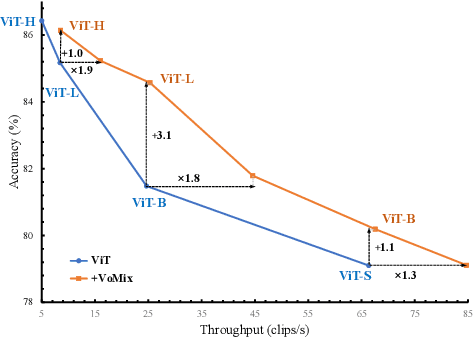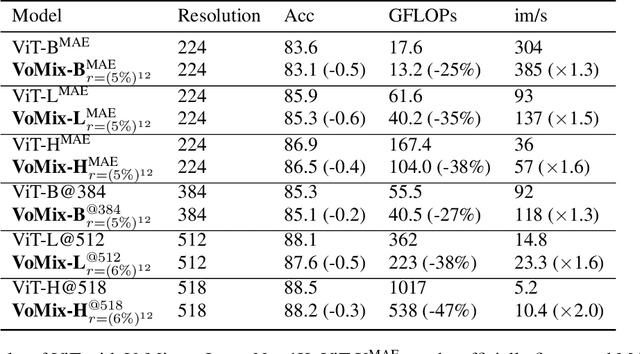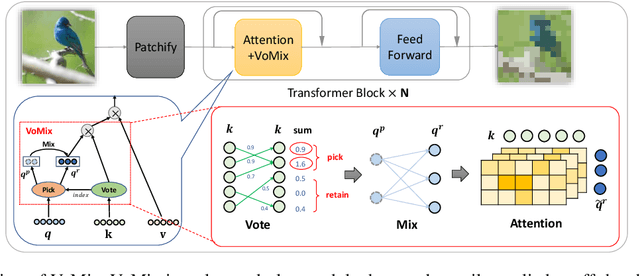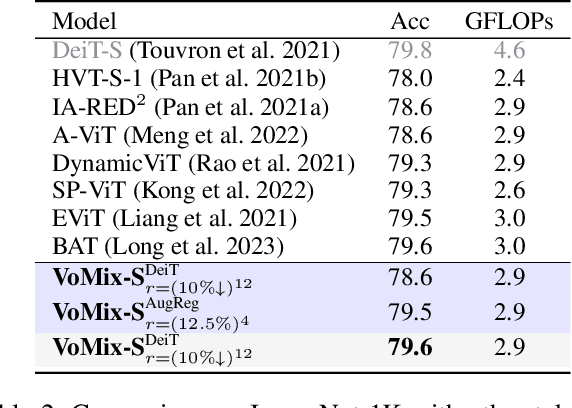Baole Wei
Vote&Mix: Plug-and-Play Token Reduction for Efficient Vision Transformer
Aug 30, 2024



Abstract:Despite the remarkable success of Vision Transformers (ViTs) in various visual tasks, they are often hindered by substantial computational cost. In this work, we introduce Vote\&Mix (\textbf{VoMix}), a plug-and-play and parameter-free token reduction method, which can be readily applied to off-the-shelf ViT models \textit{without any training}. VoMix tackles the computational redundancy of ViTs by identifying tokens with high homogeneity through a layer-wise token similarity voting mechanism. Subsequently, the selected tokens are mixed into the retained set, thereby preserving visual information. Experiments demonstrate VoMix significantly improves the speed-accuracy tradeoff of ViTs on both images and videos. Without any training, VoMix achieves a 2$\times$ increase in throughput of existing ViT-H on ImageNet-1K and a 2.4$\times$ increase in throughput of existing ViT-L on Kinetics-400 video dataset, with a mere 0.3\% drop in top-1 accuracy.
SegHist: A General Segmentation-based Framework for Chinese Historical Document Text Line Detection
Jun 25, 2024



Abstract:Text line detection is a key task in historical document analysis facing many challenges of arbitrary-shaped text lines, dense texts, and text lines with high aspect ratios, etc. In this paper, we propose a general framework for historical document text detection (SegHist), enabling existing segmentation-based text detection methods to effectively address the challenges, especially text lines with high aspect ratios. Integrating the SegHist framework with the commonly used method DB++, we develop DB-SegHist. This approach achieves SOTA on the CHDAC, MTHv2, and competitive results on HDRC datasets, with a significant improvement of 1.19% on the most challenging CHDAC dataset which features more text lines with high aspect ratios. Moreover, our method attains SOTA on rotated MTHv2 and rotated HDRC, demonstrating its rotational robustness. The code is available at https://github.com/LumionHXJ/SegHist.
Recognition-Guided Diffusion Model for Scene Text Image Super-Resolution
Nov 22, 2023Abstract:Scene Text Image Super-Resolution (STISR) aims to enhance the resolution and legibility of text within low-resolution (LR) images, consequently elevating recognition accuracy in Scene Text Recognition (STR). Previous methods predominantly employ discriminative Convolutional Neural Networks (CNNs) augmented with diverse forms of text guidance to address this issue. Nevertheless, they remain deficient when confronted with severely blurred images, due to their insufficient generation capability when little structural or semantic information can be extracted from original images. Therefore, we introduce RGDiffSR, a Recognition-Guided Diffusion model for scene text image Super-Resolution, which exhibits great generative diversity and fidelity even in challenging scenarios. Moreover, we propose a Recognition-Guided Denoising Network, to guide the diffusion model generating LR-consistent results through succinct semantic guidance. Experiments on the TextZoom dataset demonstrate the superiority of RGDiffSR over prior state-of-the-art methods in both text recognition accuracy and image fidelity.
 Add to Chrome
Add to Chrome Add to Firefox
Add to Firefox Add to Edge
Add to Edge